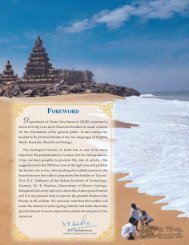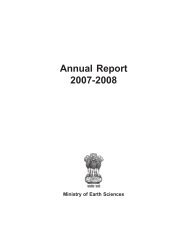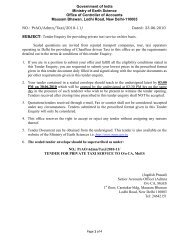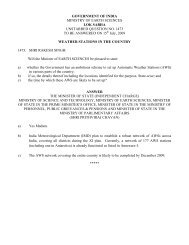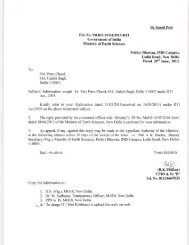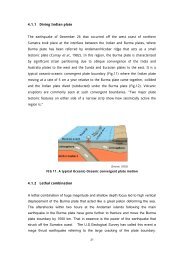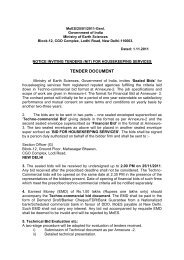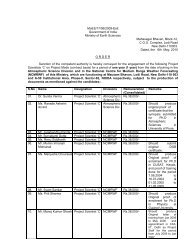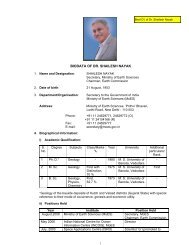1) Microzonation main Volume - Ministry Of Earth Sciences
1) Microzonation main Volume - Ministry Of Earth Sciences
1) Microzonation main Volume - Ministry Of Earth Sciences
- No tags were found...
You also want an ePaper? Increase the reach of your titles
YUMPU automatically turns print PDFs into web optimized ePapers that Google loves.
Deterministic Seismic Hazard Analysisand has published a seismotectonic map in 2000. Seismotectonic atlas (SEISAT, 2000) contains 43 maps in 42sheets of 3 o x4 o sizes with scale of 1:1 million, which also describes the tectonic frame work and seismicity.SEISAT is prepared with the intention that it can be used for the seismic hazard analysis of Indian cities. In thisanalysis about 6 SEISAT maps are merged, seismic sources with 350km in a circular area having radius aroundBangalore are used. Typical seismotectonic map is shown in Figure 3.2. Seismicity and activity of the regionwill always change based on neotectonic activity of the region. Thus it is necessary that any seismic hazardshould include recent seismicity. An extensive literature has been carried out to collect seismic sources fromrecent publications. Ganesha Raj and Nijagunappa (2004) have mapped major lineaments of Karnataka Statewith length more than 100 km using satellite remote sensing data and correlated with the earthquakeoccurrences. They have highlighted that there are 43 major lineaments and 33 earthquake occurrences withmagnitude above 3 (since 1828) in the State. About 23 of these earthquakes were associated with 8 majorlineaments, which they have named as active lineaments. The Mandya-Channapatna-Bangalore lineament,Lakshman Thirtha-KRS-Bangalore lineament, and Chelur-Kolar-Battipalle lineament are some of theseismically active lineaments identified by the authors. They have also stated that earthquakes are confined tothe southern part of the state indicating that south Karnataka is seismically more active. The authors have alsorecommended the need to upgrade the seismic zonation map of Karnataka especially for areas surroundingMandya, Bangalore, and Kolar. Karnataka lineaments published by Ganesha Raj and Nijagunappa (2004) usingremote sensing data are also considered in the present study which is shown in Figure 3.3. These sources arecompiled and seismic source map for Bangalore has been prepared which is shown in Figure 3.4. In seismichazard analysis other than the earthquake data and sources, ground motion attenuation relation is also importantwhich is discussed in the next section.3.4 SEISMICITY OF THE STUDY AREASeismicity of an area is the basic issue to be examined in seismic hazard analysis for evaluating seismic risk forthe purpose of microzonation planning of urban centres. Detailed knowledge of active faults and lineaments andassociated seismicity is required to quantify seismic hazard and risk. Indian peninsular shield, which was onceconsidered to be seismically stable, has shown that it is quite active. Seismic activity of the south India isstudied by Srinivasan and Sreenivas (1977), Valdiya (1998), Purnachandra Rao (1999), Ramalingeswara Rao(2000), Subrahmanya (2002 and 1996), Ganesha Raj (2001), Sridevi Jade (2004), Ganesha Raj and Nijagunappa(2004), Sitharam et al (2006) and Sitharam and Anbazhagan (2007). Srinivasan and Sreenivas (1977) have usedfield studies of bore well yield data and discussed the reactivation of dormant or inactive lineaments inducingseismicity in relative stable terrains of the continents. Purnachandra Rao (1999) highlighted the occurrence ofearthquakes in last few decades due to enhanced seismic activity in the interior of the Indian Plate which resultsfrom pre-existing faults under the influence of the ambient stress field due to the India-Eurasia plate collisionforces, oriented NS to NNE. Ramalingeswara Rao (2000) carried out strain rate and heat flow study in thesouthern India and characterized as medium to low seismicity region. Subrahmanya (2002 and 1996) highlightsthat the entire study area becoming seismically active due to the up warp of Mulki-Pulicat Lake (MPL) axiswhich connects 13 o N in west to 13.4 o N in east. He concludes that there is lot of seismic activity around thisMulki-Pulicat Lake axis and in particular he highlights that micro to meso-seimicity to the south and megaseismicity to the north of the MLP axis. In recent years much of the seismic activity in the state of Karnatakahas been in the south, in the Mysore-Bangalore region (Ganesha Raj and Nijagunappa, 2004). Recently, SrideviJade (2004) has estimated the plate velocity and crustal deformation in the Indian subcontinent using GPSmeasurements. The author concludes that southern peninsular India consists of large zones of complex folding,major and minor faults and granulite exposures, and this region cannot be classified as an area of low seismicactivity. All these authors highlight that the seismic activity of the south India has shown an increasing trend.Seismic data collected from various agencies [United State Geological Survey (USGS), Indian MetrologicalDepartment (IMD), NewDelhi; Geological Survey of India (GSI) and Amateur Seismic Centre (ASC), NationalGeophysical Research Institute (NGRI),Hyderabad; Centre for <strong>Earth</strong> Science Studies (CESS), Akkulam, Keralaand Gauribindanur (GB) Seismic station] contain information about the earthquake size in different scales suchas intensity, local magnitude or Richter magnitude and body wave magnitudes. These magnitudes are convertedto moment magnitudes (M w ) to achieve the status of the uniform magnitude by using magnitude relations givenby Heaton et al (1986). Some of the earthquake data is given in Table 3.1 and re<strong>main</strong>ing is listed in Annexure A.The earthquake events collated are about 1421 with minimum moment21




